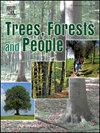Climate change-induced shifts in the ecological niches of Parkia biglobosa (Jacq.) and Vitellaria paradoxa CF Gaertn, two species of agroforestry parks in Benin, West Africa
IF 2.7
Q1 FORESTRY
引用次数: 0
Abstract
Understanding the effects of climate change on species distribution patterns is fundamental to biogeography and evolutionary ecology, especiallyfor socio-economically important agroforestry species such as Parkia biglobosa R.Br. ex Benth and Vitellaria paradoxa CF Gaertn. However, gaps remain regarding the evolution of ecological niches of these widespread species. This study examines the effects of climate change on P. biglobosa and V. paradoxa, two key species of agroforestry parklands in Benin. By integrating intraspecific variation into niche modeling, three homogeneous subgroups (North, Center, and South) were identified and analyzed under current and future climate conditions. Maximum Entropy Modeling (MaxEnt), was used, chosen for its predictive power and flexibility in correcting for data bias. Climate projections were based on common socio-economic scenarios (SSP2-4.5 and SSP5-8.5), representing a moderate mitigation scenario and a high emissions scenario, respectively. The results showed significant climate change effects across subgroups for both species, mediated by temperature and humidity. Under the SSP2-4.5 scenario, the northern subgroup of P. biglobosa exhibited habitat shifts towards the central and southern subgroup regions, while the central and southern subgroups showed predictive habitat loss. For V. paradoxa, this scenario predicted significant habitat loss for the northern and central subgroups, while the southern subgroup demonstrated habitat expansion along altitudinal gradients. The more severe SSP-5–8.5 scenario predicted extensive habitat loss for both species. The Sudano-Guinean and Guineo-Congo zones remain climatically suitable for both species under future projections. The most pronounced interspecific niche overlap occurred between the northern and southern subgroups, indicating considerable ecological similarity. These results highlight the need for climate-adaptive management strategies in agroforestry systems with particular emphasis on subgroups facing imminent habitat loss. Future research directions should explore adaptive management approaches while maintaining essential ecosystem services and supporting local livelihoods.
气候变化对西非贝宁农林业公园两种植物——大叶树苗(Parkia biglobosa, Jacq.)和野Vitellaria paradoxa CF Gaertn生态位的影响
了解气候变化对物种分布格局的影响是生物地理学和进化生态学研究的基础,特别是对具有重要社会经济意义的农林业物种,如大叶杉木。参见Benth和Vitellaria paradoxa CF gaern。然而,关于这些广泛分布的物种的生态位的演变,仍然存在空白。本研究探讨了气候变化对贝宁农林业公园两种关键物种大叶假种和悖论假种的影响。通过将种内变化整合到生态位模型中,确定并分析了当前和未来气候条件下的三个同质亚群(北、中、南)。使用最大熵模型(MaxEnt),选择它是因为它的预测能力和修正数据偏差的灵活性。气候预估基于常见的社会经济情景(SSP2-4.5和SSP5-8.5),分别代表中度缓解情景和高排放情景。结果表明,在温度和湿度的介导下,气候变化对两个物种的亚群都有显著的影响。在SSP2-4.5情景下,大叶伪种北部亚群向中部和南部亚群迁移,而中部和南部亚群则表现出预测性的栖息地丧失。在这一情景下,悖论弧菌北部亚群和中部亚群的栖息地明显减少,而南部亚群的栖息地则沿海拔梯度扩展。更严重的SSP-5-8.5情景预测了这两个物种的广泛栖息地丧失。根据未来的预测,苏丹-几内亚和几内亚-刚果地区的气候仍然适合这两种物种。最明显的种间生态位重叠发生在北部和南部亚群之间,表明相当大的生态相似性。这些结果突出了农林复合系统中气候适应性管理战略的必要性,特别强调了面临迫在眉睫的栖息地丧失的亚群。未来的研究方向应探索适应性管理方法,同时保持基本的生态系统服务和支持当地生计。
本文章由计算机程序翻译,如有差异,请以英文原文为准。
求助全文
约1分钟内获得全文
求助全文
来源期刊

Trees, Forests and People
Economics, Econometrics and Finance-Economics, Econometrics and Finance (miscellaneous)
CiteScore
4.30
自引率
7.40%
发文量
172
审稿时长
56 days
 求助内容:
求助内容: 应助结果提醒方式:
应助结果提醒方式:


